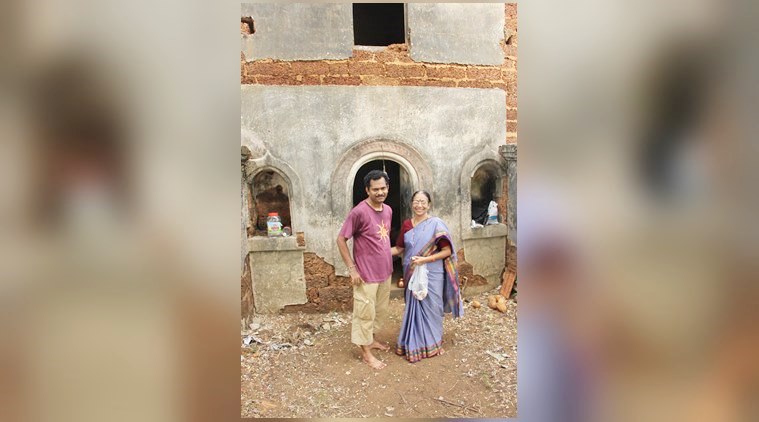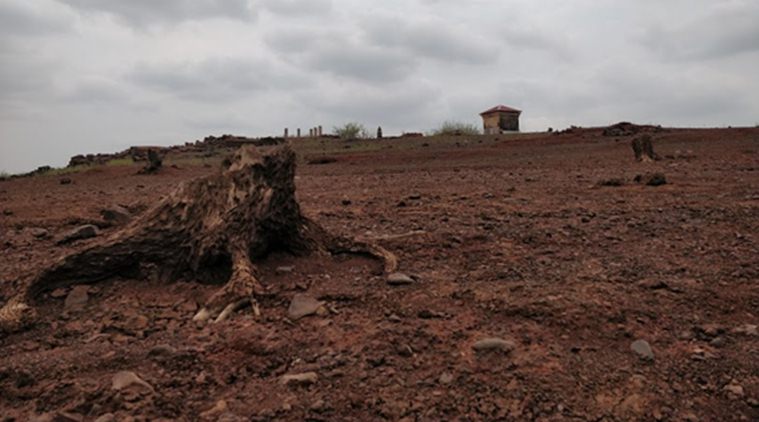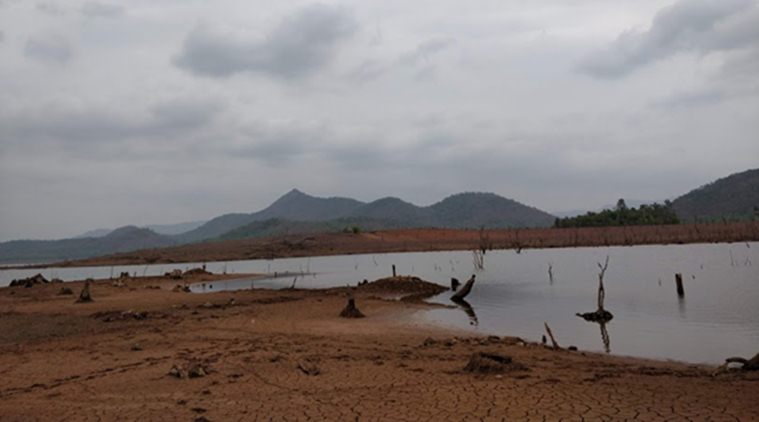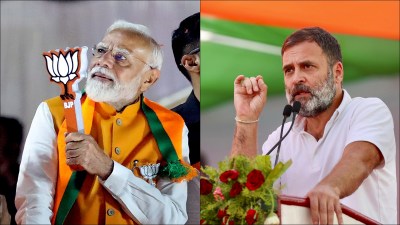- India
- International
The village of Kurdi in Goa: Now you see it, now you don’t
Once a year, a Goan village, submerged by a dam in the 1980s, resurfaces. For Kurdi’s people, that is the time to return home.
 Gurucharan Kurdikar with mother Mamata. (Photo: Gurucharan Kurdikar)
Gurucharan Kurdikar with mother Mamata. (Photo: Gurucharan Kurdikar)
In the summer of 2009, Venisha Fernandes, 31, sat on a cement soppo (Portuguese for a seat) and attempted to mentally recreate a scenario from the 1960s — her father Jose Paul Fernandes, then a child, sitting in the same soppo and listening to the radio in his neighbour’s home. At that very moment, her father and her uncle were tracing their home’s outlines on a barren muddy landscape in south-east Goa, and a calming breeze was nudging her to imagine the ruins as what they had been — Kurdi, the ancestral village of her forefathers.
In the early 1980s, with south Goa’s growing population in need of water, Kurdi had to be submerged to build a dam across Salaulim, a tributary of the Zuari, and a reservoir built to supply filtered water. Around 634 families were displaced, who were allotted agriculture and residential land in two new villages, 15 km away — Vaddem and Valkinim. By 1986, with the Western Ghats holding a good monsoon and a new dam constructed, the water levels rose steadily, drowning their homes, living spaces, pushing reluctant Kurdi residents to fold their lives and migrate.
Every year, for four weeks between May and June, Kurdi resurfaces, magically, confirming the living memories of an entire village; giving the natives a tiny window of opportunity to reclaim their home again.
“Kurdi is the Mohenjo Daro of Goa…the Egypt of Goa. People’s memory has played a crucial role in keeping Kurdi alive,” says Venisha, a 2009 Goa University sociology student and now an assistant professor of sociology. For a dissertation in 2009, she chose to archive the oral histories of her Kurdi’s natives. Her research inspired filmmaker Saumyananda Sahi to make a documentary Remembering Kurdi (2016). Her dissertation will soon be a part of a book on “life in Goan villages”, and a Brazil-based academician is helping archive Kurdi into an oral narrative history project. This year, over 6,000 people have visited Kurdi — which Kurdikars identify as a “graveyard of memories” — for its annual Someshwar temple feast. The sanctum is otherwise submerged through the year.
 Here once stood homes by the banks of the river Salaulim, and the temple in the horizon. (Photos: Smita Nair)
Here once stood homes by the banks of the river Salaulim, and the temple in the horizon. (Photos: Smita Nair)
Between May and June, as the water level recedes, out pops Jose’s neighbour’s cement soppo, ghostly hollow tree trunks, the sanctum of the 18th century Someshwar temple, the edifice of Sacred Heart of Jesus Chapel, a ground-level structure of what once used to be a rice mill, flour mill, the local bar, a provisions store, a fair price shop, a police station, muddy mounds showing traces of homes, the borders of the village canal, a half-standing police check post, a school without the sounds of its children (each row, the villagers recall, was a separate class; the school declared a holiday if the bus bringing the teacher from another village didn’t turn up), and the clean pathways built by the Portuguese where once stood the colonial border military guarding the state from the Indian army. “It’s emotional even for the spectator to watch. Everything is imagined, every year. It then becomes a collective annual exercise of reviving memories,” says historian-author Pandurang Phaldesai.

“It’s the only historical village of Goa that remains submerged under water. A stone-carved figure of a mother goddess from 6th century BC, believed to be Mother Earth, is from here. Before the water levels rose, she was shifted by the ASI (Archaeological Survey of India) to Verna in Salcete Taluka. While the main deity of Someshwar could not be relocated, the shrines were. It was (the late Hindustani classical singer) Kishori Amonkar who helped in relocating one of the shrines, of Ravalnath. She is a daughter of Kurdi. Her mother and sangeet guru Mogubai Kurdikar lived in a home facing the temple,” says Phaldesai. He recalls Amonkar’s assistants borrowing musical instruments in the early days of her performances at Kurdi from the state’s Kala Academy.
Under her sociology professor Alito Siqueira’s guidance, Venisha went to see what makes the villagers — the earlier tenants of a feudal agriculture system, now endowed with government compensation (10,000 sq. m cultivation land, 400 sq. m of settlement, and a government job) — still long to return to Kurdi.
“Kurdi is no longer productive but this is where they toiled, grew paddy and sugarcane, bathed in the river. Land is never about owning it alone. They were tenants here. But as landlords in the other village, they continue to return here,” she says. “Most villagers continue to identify themselves as Kurdikars, retaining it as their second name, even though the village remains submerged.”
At Kurdi, on a summer weekend, it’s a common sight to see villagers standing by their “kitchen” or “walking in the corridor between rooms”. Venisha recalls the many stories that the natives have narrated to her — “that bed from Kurdi” which gives them a comfortable sleep even today, “vivid dreams of Kurdi”, the “wife who continues to nag her husband for forgetting to pack the kitchen spoons in 1985”. Of the Christian and Muslim families who stand with heads bowed to their ancestors, buried deep inside the village’s damp soil.
 Every year, for four weeks between May and June, Kurdi resurfaces, magically, confirming the living memories of an entire village; giving the natives a tiny window of opportunity to reclaim their home again.
Every year, for four weeks between May and June, Kurdi resurfaces, magically, confirming the living memories of an entire village; giving the natives a tiny window of opportunity to reclaim their home again.
During the making of Remembering Kurdi, native Gurucharan Kurdikar, 42, now settled in Bengaluru, recalled the bhajan session of Mogubai Kurdikar and suggested recreating it for the shoot. “We repeated it the next year, and now it’s a regular event. Since then, the number of devotees for the Someshwar temple bhajan and feast have been increasing,” says Gurucharan, who posts updates on the “annual phenomenon” on his Facebook page “Remembering Kurdi-Curdi”. He speaks of the fabled tiger den, believed to be a spot where the tigers rested, the archaeological moon dial, the select hero stones excavated, or the “peculiar and mysterious carvings” still etched on the inner temple walls. “As a child, I would sit at my father’s shop selling 20-paise cigarettes. Those five rooms that emerge every year were our shop and the mills,” he says. “We could take only the timber and tiles from the roofs to build our new home. Whoever comes here gets only one chance in a year. You can’t wake up in December and say I want to see Kurdi.”
Caterer Ajay Kurdikar, 52, from Valkinim, says that 300 kg rice, 80 kg pulses, 100 kg vegetables and “40 bottles of pickle” went into preparing the temple feast this year. The temple feast is hosted on the third Sunday of May and the chapel feast follows on the fourth Sunday with a mass. The litany, that was sung at the chapel till 2011, has been converted into a mass and Sunday feast. Ajay’s favourite Kurdi story is of husbands instructing wives to remain indoors in the 1950s-60s, when the “mischievous Portuguese soldiers came asking for kombdi (chicken)”.
 The structure had a provision shop, flour mills, police station and a bar.
The structure had a provision shop, flour mills, police station and a bar.
Gurucharan’s mother Mamata, 65, remembers entering Kurdi as a bride-to-be, invited by her “mister” to “check out the village without electricity”. The 20-year-old city girl from Belgaum found it to be fascinating. “All communities living together, the cashew orchards, the line of jackfruit trees, and the fragrance of babuli, which I can still recall. Everything could be adjusted to after that fragrance. I said ‘yes’ to the marriage,” she says of a lifetime spent by the river, gossiping and washing with her women friends. Now, at the new village, she questions the displacement policy, as there are taps but no water, bulbs but no electricity — the womenfolk depend on water tanks, with borewells not giving enough. The Petromax that lit her old home continues to be used, partially to recreate a Kurdi evening, and partially owing to the failure of the consecutive Goa governments in providing electricity. With no proper policy or planning, the water is directed to south Goa’s western towns and the ground water table is too low in Vaddem and Valkinim to quench their needs. “My husband still sits by the village temple and watches the horizon of the dam and the submerged village through the year. Every evening he returns sullen. We had to pay the price.”
Venisha, now married and in Sanvordem, with the Salaulim dam quenching her thirst, agrees. In a 2009 note, she wrote, overwhelmed after being told her grandparents are buried in Kurdi, “…the water that touches their bones, I drink today.”
This article appeared in print with the headline ‘Now You See It, Now You Don’t’
Apr 25: Latest News
- 01
- 02
- 03
- 04
- 05








































